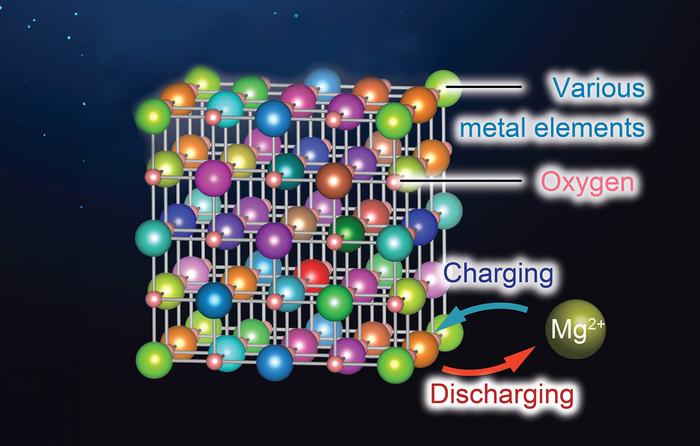Rechargeable magnesium batteries (RMBs) have been of great interest as energy storage devices beyond lithium-ion batteries due to their potentially high energy density and the abundance of magnesium in the earth's crust. However, the commercialization of this type of technology has been held back by the lack of appropriate cathode materials.
Now, researchers at Tohoku University in Japan have developed a novel cathode material for RMBs, leveraging an enhanced rock-salt structure, which enables efficient charging and discharging even at low temperatures.
Their study showcases a considerable improvement in magnesium diffusion within a rock-salt structure, a critical advancement since the denseness of atoms in this configuration had previously impeded magnesium migration.
By introducing a strategic mixture of seven different metallic elements (Mg0.35Li0.3Cr0.1Mn0.05Fe0.05Zn0.05Mo0.1O), the researchers created a crystal structure abundant in stable cation vacancies, facilitating easier magnesium insertion and extraction. They reported that extracting lithium cations in the first charging leads to a substantial amount of cation vacancies in the rocksalt structure, facilitating magnesium (Mg) diffusion in subsequent cycles.
This represents the first utilization of rocksalt oxide as a cathode material for RMBs. The development also addresses a key limitation of RMBs – the difficulty of magnesium transport within solid materials.
Popular content
Until now high temperatures have been necessary to enhance Mg mobility in conventional cathode materials, such as those with a spinel structure. However, the material unveiled by Tohoku University researchers purportedly operates efficiently at 90 C, demonstrating a significant reduction in the required operating temperature.
The researchers reported that the new material yielded a reversible capacity of around 90 mA h g−1 at a current density of 10.4 mA g−1 with a potential of around 2.0 V vs. Mg2+/Mg at 90 C, which was a relatively low temperature in comparison with that for the previously reported spinel-oxide cathodes operated at 150 C.
“Magnesium batteries, featuring the newly developed cathode material, are poised to play a pivotal role in various applications, including grid storage, electric vehicles, and portable electronic devices, contributing to the global shift towards renewable energy and reduced carbon footprints,” said the research's lead author, Tomoya Kawaguchi.
The research findings were discussed in “Securing cation vacancies to enable reversible Mg insertion/extraction in rocksalt oxides,” published in the Journal of Materials Chemistry A.
This content is protected by copyright and may not be reused. If you want to cooperate with us and would like to reuse some of our content, please contact: editors@pv-magazine.com.



By submitting this form you agree to pv magazine using your data for the purposes of publishing your comment.
Your personal data will only be disclosed or otherwise transmitted to third parties for the purposes of spam filtering or if this is necessary for technical maintenance of the website. Any other transfer to third parties will not take place unless this is justified on the basis of applicable data protection regulations or if pv magazine is legally obliged to do so.
You may revoke this consent at any time with effect for the future, in which case your personal data will be deleted immediately. Otherwise, your data will be deleted if pv magazine has processed your request or the purpose of data storage is fulfilled.
Further information on data privacy can be found in our Data Protection Policy.